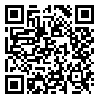Volume 4, Issue 2 (June 2025)
IJER 2025, 4(2): 0-0 |
Back to browse issues page
Download citation:
BibTeX | RIS | EndNote | Medlars | ProCite | Reference Manager | RefWorks
Send citation to:



BibTeX | RIS | EndNote | Medlars | ProCite | Reference Manager | RefWorks
Send citation to:
Babaei B, Shabani Varaki B. (2025). Methodological Critique of Teaching and Learning Methods from the Perspective of Embodiment. IJER. 4(2),
URL: http://ijer.hormozgan.ac.ir/article-1-358-en.html
URL: http://ijer.hormozgan.ac.ir/article-1-358-en.html
1- Psychology Education and Counseling Department, Farhangian University, P.O,BOX 889-14665. Tehran, Iran , b.babaei@cfu.ac.ir
2- Professor, Department of Educational Science, Ferdowsi University of Mashhad, Mashhad, Iran
2- Professor, Department of Educational Science, Ferdowsi University of Mashhad, Mashhad, Iran
Abstract: (1082 Views)
Objective: The main objective of the present study is to explain the methodological difficulties of teaching and learning approaches from the perspective of embodiment.
Methods: The research method is logical inference, which aims to clarify the conceptual structures, analysis, and logical relevance of propositions in order to achieve a valid understanding of what, how, and why teaching and learning are.
Results: The outcome indicates that prevailing pedagogical methodologies encounter challenges that are both dualistic and related to the delivery of objective and subjective experiences, founded upon the existential interplay between teaching and learning; this necessitates the incorporation, augmentation, synthesis, and engagement through neurophenomenology within the intricate dimensions of teacher-learner dynamics situated within the physical, cultural, and emotional milieu of the classroom.
Conclusions: Based on the holistic and embodied approach to teaching and learning methods; the pillars of teaching, learning, teacher-learner relationships, and the design of the learning environment need to be revised. Therefore, in teaching and learning, the proposal of a situational, neurophenomenological, flexible, fluid, and bricolage-based approach is emphasized. Another result of the research is that the curriculum is dynamic, evolving, emerging, holistic, and multifaceted. The teacher-student relationship is dynamic and layered. The learning and assessment environment is both cognitive and emotional, and ultimately all the elements of teaching and learning are integrated.
Methods: The research method is logical inference, which aims to clarify the conceptual structures, analysis, and logical relevance of propositions in order to achieve a valid understanding of what, how, and why teaching and learning are.
Results: The outcome indicates that prevailing pedagogical methodologies encounter challenges that are both dualistic and related to the delivery of objective and subjective experiences, founded upon the existential interplay between teaching and learning; this necessitates the incorporation, augmentation, synthesis, and engagement through neurophenomenology within the intricate dimensions of teacher-learner dynamics situated within the physical, cultural, and emotional milieu of the classroom.
Conclusions: Based on the holistic and embodied approach to teaching and learning methods; the pillars of teaching, learning, teacher-learner relationships, and the design of the learning environment need to be revised. Therefore, in teaching and learning, the proposal of a situational, neurophenomenological, flexible, fluid, and bricolage-based approach is emphasized. Another result of the research is that the curriculum is dynamic, evolving, emerging, holistic, and multifaceted. The teacher-student relationship is dynamic and layered. The learning and assessment environment is both cognitive and emotional, and ultimately all the elements of teaching and learning are integrated.
Type of Study: Original |
Subject:
Educational Studies
Received: 2024/10/10 | Accepted: 2025/01/15 | Published: 2025/06/1
Received: 2024/10/10 | Accepted: 2025/01/15 | Published: 2025/06/1
Send email to the article author
| Rights and permissions | |
 |
This work is licensed under the Creative Commons - Attribution 4.0 International. |






